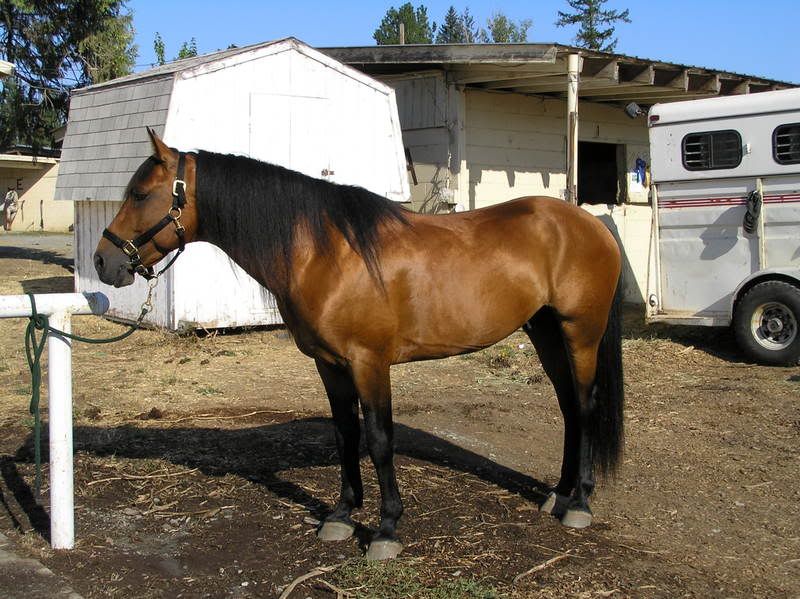Post by sbutter on Jun 6, 2011 2:07:47 GMT -5
For a corpus luteum either a shot of Prostine (prostaglandin) or Lutalyse. It worked for the mare here and she now has regular cycles and comes in heat strong when she is ready. I don't know if there are any alternative ways to fix the problem, but this what all the vets we talk to recommend for this particular situation. I would talk to a vet about LadyRose to make sure there aren't any other reasons for the lack of a cycle.
I did a quick google search to help explain it in technical terms. Here is a snippet for both prostagladin and then Lutalyse with the links I got them from.
"After the release of the egg, a corpus luteum is formed at the site of ovulation. The function of the CL is to produce the hormone progesterone which will help maintain the impending pregnancy. If a pregnancy does not occur, the body is notified by the uterus by producing prostaglandin. Prostaglandin then attacks and kills the CL which allows the mare to begin another reproductive cycle.
Commercial production of F2 alpha prostaglandin allows horse breeders to, theoretically, shorten the cycle by killing the CL and coaxing the barren mare back into heat. This is especially useful in those situation where the mare retains her CL longer than normal therefore delaying her cycle."
www.pyramidarabians.com/news/prostaglandin.html
--------------------------
"Mares: LUTALYSE Sterile Solution is indicated for its luteolytic effect in mares. This luteolytic effect can be utilized to control the timing of estrus in estrous cycling and clinically anestrous mares that have a corpus luteum in the following circumstances:
1. Controlling Time of Estrus of Estrous Cycling Mares: Mares treated with LUTALYSE during diestrus (4 or more days after ovulation) will return to estrus within 2 to 4 days in most cases and ovulate 8 to 12 days after treatment. This procedure may be utilized as an aid to scheduling the use of stallions.
2. Difficult-to-Breed Mares: In extended diestrus there is failure to exhibit regular estrous cycles which is different from true anestrus. Many mares described as anestrus during the breeding season have serum progesterone levels consistent with the presence of a functional corpus luteum.
A proportion of “barren”, maiden, and lactating mares do not exhibit regular estrous cycles and may be in extended diestrus. Following abortion, early fetal death and resorption, or as a result of “pseudopregnancy”, there may be serum progesterone levels consistent with a functional corpus luteum.
Treatment of such mares with LUTALYSE usually results in regression of the corpus luteum followed by estrus and/or ovulation. In one study with 122 Standardbred and Thoroughbred mares in clinical anestrus for an average of 58 days and treated during the breeding season, behavioral estrus was detected in 81 percent at an average time of 3.7 days after injection with 5 mg LUTALYSE; ovulation occurred an average of 7.0 days after treatment. Of those mares bred, 59% were pregnant following an average of 1.4 services during that estrus."
www.allivet.com/Lutalyse-p/25107.htm
Hope this helps
I did a quick google search to help explain it in technical terms. Here is a snippet for both prostagladin and then Lutalyse with the links I got them from.
"After the release of the egg, a corpus luteum is formed at the site of ovulation. The function of the CL is to produce the hormone progesterone which will help maintain the impending pregnancy. If a pregnancy does not occur, the body is notified by the uterus by producing prostaglandin. Prostaglandin then attacks and kills the CL which allows the mare to begin another reproductive cycle.
Commercial production of F2 alpha prostaglandin allows horse breeders to, theoretically, shorten the cycle by killing the CL and coaxing the barren mare back into heat. This is especially useful in those situation where the mare retains her CL longer than normal therefore delaying her cycle."
www.pyramidarabians.com/news/prostaglandin.html
--------------------------
"Mares: LUTALYSE Sterile Solution is indicated for its luteolytic effect in mares. This luteolytic effect can be utilized to control the timing of estrus in estrous cycling and clinically anestrous mares that have a corpus luteum in the following circumstances:
1. Controlling Time of Estrus of Estrous Cycling Mares: Mares treated with LUTALYSE during diestrus (4 or more days after ovulation) will return to estrus within 2 to 4 days in most cases and ovulate 8 to 12 days after treatment. This procedure may be utilized as an aid to scheduling the use of stallions.
2. Difficult-to-Breed Mares: In extended diestrus there is failure to exhibit regular estrous cycles which is different from true anestrus. Many mares described as anestrus during the breeding season have serum progesterone levels consistent with the presence of a functional corpus luteum.
A proportion of “barren”, maiden, and lactating mares do not exhibit regular estrous cycles and may be in extended diestrus. Following abortion, early fetal death and resorption, or as a result of “pseudopregnancy”, there may be serum progesterone levels consistent with a functional corpus luteum.
Treatment of such mares with LUTALYSE usually results in regression of the corpus luteum followed by estrus and/or ovulation. In one study with 122 Standardbred and Thoroughbred mares in clinical anestrus for an average of 58 days and treated during the breeding season, behavioral estrus was detected in 81 percent at an average time of 3.7 days after injection with 5 mg LUTALYSE; ovulation occurred an average of 7.0 days after treatment. Of those mares bred, 59% were pregnant following an average of 1.4 services during that estrus."
www.allivet.com/Lutalyse-p/25107.htm
Hope this helps









